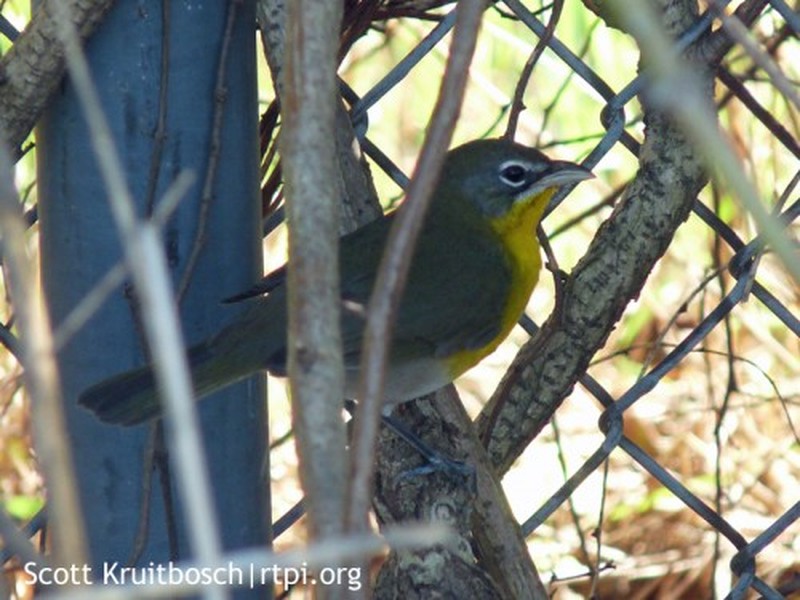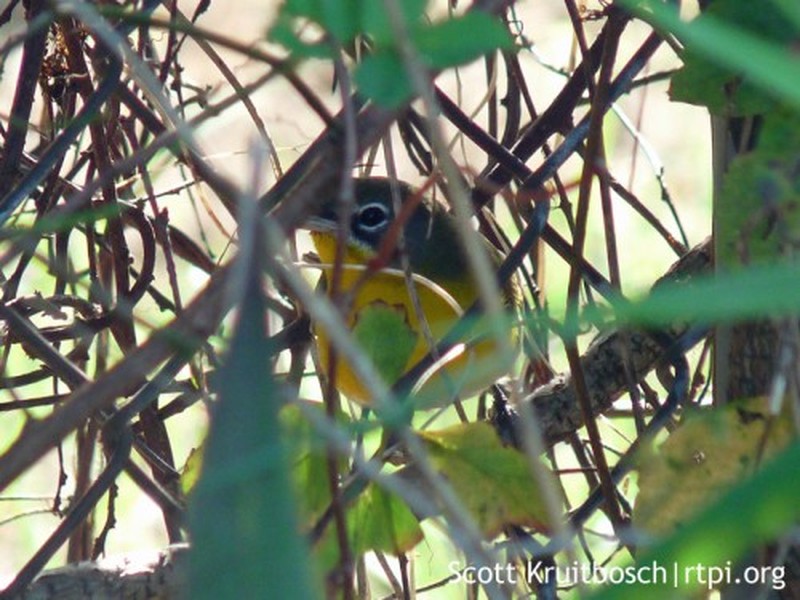Yellow-breasted Chat
Icteria virens (Linnaeus, 1758)
- Class
- Aves (Birds)
- Family
- Icteriidae
- State Protection
- Special Concern
Listed as Special Concern by New York State: at risk of becoming Threatened; not listed as Endangered or Threatened, but concern exists for its continued welfare in New York; NYS DEC may promulgate regulations as to the taking, importation, transportation, or possession as it deems necessary.
- Federal Protection
- Migratory Bird Treaty Act
The Migratory Bird Treaty Act implements various treaties and conventions between the U. S. and Canada, Japan, Mexico and the former Soviet Union for the protection of migratory birds. Under this Act, taking, killing, or possessing migratory birds, including nests or eggs, is unlawful unless specifically permitted by other regulations.
- State Conservation Status Rank
- S2?B
Imperiled in New York (most likely) - Conservation status is uncertain, but most likely very vulnerable to disappearing from New York due to rarity or other factors; typically 6 to 20 populations or locations in New York, very few individuals, very restricted range, few remaining acres (or miles of stream), and/or steep declines. More information is needed to assign a firm conservation status. (A migratory animal which occurs in New York only during the breeding season.)
- Global Conservation Status Rank
- G5
Secure globally - Common in the world; widespread and abundant (but may be rare in some parts of its range).
Summary
Did you know?
Males perform display flights during the breeding season for females, other males, or human intruders (Cornell Lab of Ornithology 2019). From a perch or hovering, the male sings and drops slowly with exaggerated wing flapping. A hollow, thumping sound likely made by the wings ends the flight.
State Ranking Justification
Yellow-breasted Chats were once more common breeders in the state, but these birds declined by 78% between the first and second Breeding Bird Atlas (McGowan and Corwin 2008), and currently there are four known locations in New York (NYNHP 2020). Suitable habitat for this species appears to be on the decline (Levine 1998, NatureServe 2019) due to development and forest succession.
Short-term Trends
The short-term trend for Yellow-breasted Chats in in New York is unknown, but it is likely stable or declining. Only four occurrences, in the Hudson Valley and on Long Island, have been documented in the last 15 years (NYNHP 2020).
Long-term Trends
The long-term trend of Yellow-breasted Chat in New York shows a decline. At one point these birds were common breeders on Long Island, Staten Island, and in the lower Hudson Valley (Levine 1998). A 1940 breeding survey found them in 10 locations on Long Island and 11 locations in Westchester and Rockland Counties (Bull 1964). Breeding on Long Island had been reduced and become more localized by the 1990s (Levine 1998). There was a 78% decline in Breeding Bird Atlas blocks between the first (1980-1985) and second (2000-2005) atlases, with yellow-breasted chat only detected in 27 blocks in the second atlas with only one block having confirmed breeding (McGowan and Corwin 2008). Shrubland habitat for these birds has also been declining in the state (McGowan and Corwin 2008), which may explain some of the declining trend.
Conservation and Management
Threats
The main threat to Yellow-breasted Chat in New York is habitat loss. These birds likely became more common breeders in New York when European settlers arrived and began clearing forests (McGowan and Corwin 2008). Populations seem to have declined once old fields began to succeed into forest or were cleared for development (Levine 1998, NatureServe 2019, Eckerle and Thompson 2020) because they breed in dense, shrubby areas to breed in (Levine 1998). Additionally, this species is parasitized by Brown-headed Cowbird (Molothrus ater), although it is not known if this a significant threat to their success (NatureServe 2019)
Conservation Strategies and Management Practices
Management needs for Yellow-breasted Chat revolve around conserving early successional forest and shrubland due to their breeding habitat requirements (Eckerle and Thompson 2020). The size of the habitat patches appears to be important for Yellow-breasted Chat; Shake et al. (2012) found that chats in North Carolina appeared to require a minimum patch size of 2.3 ha. Patches of shrubby habitat greater than 5 ha can support breeding populations (NatureServe 2019). Forest management with rotating timber cuts ensures there is always some breeding habitat available for these birds (Wallendorf et al. 2007). Clear-cutting and shelterwood cutting that leaves behind shrubs can create new habitat through natural succession, and powerline rights-of-way can be managed to encourage dense shrubbery suitable for breeding chats. (NatureServe 2019).
Research Needs
Further research into minimum patch size requirements (NatureServe 2019) and the relationship between population density of chats and breeding habitat availability is needed (Eckerle and Thompson 2020). Additionally, research into how the reproductive success of Yellow-breasted Chats is affected by Brown-headed Cowbird (Molothrus ater) brood parasitism would be beneficial.
Habitat
Habitat
Chat breed in dense shrubby habitats, such as old pastures, thickets, regenerating logged forest, and fencerows (NatureServe 2019, McGowan and Corwin 2008). They also utilize habitat along wet areas such as streams, ponds, and swamps. Chats nest in dense vegetation, generally less than 2 meters above the grounds, such as bushes, vines, and low trees (NatureServe 2019, Bull 1964). Ricketts and Ritchison (2000) found that chats at their study site in Kentucky were more likely to fledge young in nesting sites with an open overstory and dense understory with brushy cover below one meter.
Range
New York State Distribution
Chats have been recently observed in southeastern New York in the lower Hudson Valley and Long Island. The only confirmed record of breeding during the second Breeding Bird Atlas was in Sullivan county (McGowan and Corwin 2008). Yellow-breasted Chats have also been observed scattered throughout several western New York counties during breeding season, with some possibly breeding.
Global Distribution
Yellow-breasted Chats occur throughout much of North and Central Americas. Breeding populations occur across the continental United States except for northern New England, and extend northward into British Columbia, Alberta, Saskatchewan, and Ontario. Breeding populations can also be found within Mexico. Non-breeding populations occur in Mexico and south through Central America and Florida.
Identification Comments
Identifying Characteristics
Chats have a large head with a heavy, black, slightly curved bill and a long tail. Adults are olive green on their back, wings, and tail with a white lower belly (Cornell Lab of Ornithology 2019). These birds get their name from the bright yellow throat and breast. They have a gray head with a white mustachial stripe and the appearance of "spectacles" created by a white eyering that connects to the bill. Males and females looks similar, but during breeding season females have grayish lores and a gray lower mandible as opposed to black for males. Males have a great variety of songs consisting of caw notes, whistles, cackles, gurgles and other noises that are repeated and strung together in different ways (Cornell Lab of Ornithology 2019, Eckerle and Thompson 2020). Songs can be similar to a mockingbird but are more limited with longer pauses between phrases (Peterson 1980). Adults also make a variety of calls that include single notes and harsh scolding (Peterson 1980, Cornell Lab of Ornithology 2019), and also defend winter territories with a “chuck” call.
Best Life Stage for Proper Identification
Adult.
Behavior
During breeding season males will sing in the morning and evening and occasionally at night (Cornell Lab of Ornithology 2019). These birds generally hide and skulk in the dense brush of their breeding habitat, so you are more likely to hear one than see it; however, males will sometimes sing from an exposed perch during the spring. Studies suggest pairs are 90-95% monogamous (Eckerle and Thompson 2020).
Diet
Yellow-breasted Chats mostly eat insects and spiders gathered from foliage, especially during the breeding season, but also eat small fruits when available (Cornell Lab of Ornithology 2019, NatureServe 2019, Eckerle and Thompson 2020)
Best Time to See
Males arrive at their breeding territories around mid-May (Eckerle and Thompson 2020). Bull (1964) lists chats as rare in the state before mid-May and after October. Eggs are typically laid in late May to mid-July. Nests are open, bulky cups composed of grasses, leaves, bark, and weed stems (Eckerle and Thompson 2020). Females usually lay 3-5 eggs, and incubation lasts 10-12 days (Cornell Lab of Ornithology 2019, NatureServe 2019). Both parents tend to the young (Cooper and Ritchison 2005), which are born helpless with closed eyes. Young leave the nest approximately 7-10 days after hatching.
- Active
- Reproducing
The time of year you would expect to find Yellow-breasted Chat active and reproducing in New York.
Similar Species
- Northern Mockingbird (Mimus polyglottos)
Mockingbirds have similar calls, but the chat has a more limited song pattern and has longer pauses between phrases. Mockingbirds also usually repeat their song three times, while chats are more variable.
- Yellow-throated Vireo (Vireo flavifrons)
Yellow-throated Vireos have a yellow head in addition to the yellow throat a breast, and lack a white eye ring.
- Blue-headed Vireo (Vireo solitarius)
Blue-headed Vireos also have a white eye ring, but lack the yellow throat and breast.
Yellow-breasted Chat Images
Taxonomy
Yellow-breasted Chat
Icteria virens (Linnaeus, 1758)
- Kingdom Animalia
- Phylum Craniata
- Class Aves
(Birds)
- Order Passeriformes
(Perching Birds)
- Family Icteriidae
- Order Passeriformes
(Perching Birds)
- Class Aves
(Birds)
- Phylum Craniata
Additional Resources
References
Bull, John. 1974. Birds of New York State. Doubleday, Garden City, New York. 655 pp.
Cooper, S. W., and G. Ritchison. 2005. Nestling provisioning by male and female yellow-breasted chats: no relationships between morphology and parental care. Journal of Field Ornithology 76:298–302.
Cornell Lab of Ornithology. All about birds: yellow-breasted chat. 2019. Cornell Lab of Ornithology, Ithaca, New York. Available https://www.allaboutbirds.org/guide/Yellow-breasted_Chat/id (Accessed: January 27, 2020).
Eckerle, K. P. and C. F. Thompson. 2020. Yellow-breasted Chat (Icteria virens), version 1.0. In Birds of the World (A. F. Poole and F. B. Gill, Editors). Cornell Lab of Ornithology, Ithaca, NY, USA. https://doi.org/10.2173/bow.yebcha.01
Levine, E. 1998. Bull's birds of New York State. Comstock Publishing Associates, Ithaca, NY.
McGowan, K.J. and K. Corwin, eds. 2008. The Second Atlas of Breeding Birds in New York State: 2000-2005. Cornell University Press, Ithaca, NY. 688 pp.
NatureServe. 2019. NatureServe Explorer: An online encyclopedia of life [web application]. Version 7.1. NatureServe, Arlington, Virginia. Available http://explorer.natureserve.org. (Accessed: January 24, 2020).
New York Natural Heritage Program. 2024. New York Natural Heritage Program Databases. Albany, NY.
Peterson, R. T. 1980. A field guide to the birds east of the Rockies, 4th edition. Houghton Mifflin Company.
Ricketts, M. S., and G. Ritchison. 2000. Nesting success of yellow-breasted chats: effects of nest site and territory vegetation structure. The Wilson Bulletin 112:510–516.
Shake, C. S., C. E. Moorman, J. D. Riddle, and M. R. Burchell II. 2012. Influence of patch size and shape on occupancy by shrubland birds. The Condor 114:268–278.
Wallendorf, M. J., P. A. Porneluzi, W. K. Gram, R. L. Clawson, and J. Faaborg. 2007. Bird response to clear cutting in Missouri Ozark forests. Journal of Wildlife Management 71:1899–1905.
Links
About This Guide
This guide was authored by: Ashley Ballou
Information for this guide was last updated on: September 28, 2020
Please cite this page as:
New York Natural Heritage Program. 2024.
Online Conservation Guide for
Icteria virens.
Available from: https://guides.nynhp.org/yellow-breasted-chat/.
Accessed July 27, 2024.


